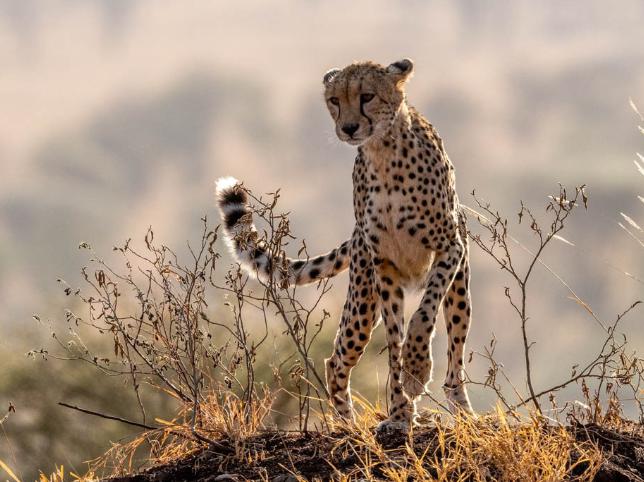Now a team of international scientists and biologists have questioned the “incomplete” cheetah action plan with an unscientific approach relying on “ decade-old flawed projections from Namibia”. Making a scathing attack on the translocation project of the iconic species in Kuno National Park, 8 scientists and conservationists write in an international journal that this may lead to “human –cheetah conflict. They “advised” to “prepare a revised science based” action plan.
The Great Cheetah Divide
The Cheetah Introduction Action Plan developed by the Wildlife Institute of India (WII) and the National Tiger Conservation Authority (NTCA) and of the Union ministry of Environment, Forests and Climate Change (MoEFC&C). Many experts from Namibia and South Africa have supported the plan. As controversy followed the cheetah translocation in Kuno national park, 8 cheetahs were released by the prime minister of India Narendra Modi on his birthday on September 17 this year. The cheetahs were flown from Namibia and were accompanied by the consultant on the project Dr Laurie Marker and her team of Cheetah Conservation Fund (CCF). After the release she said that, “if we can save the cheetah , we can change the world or we have changed the world to save the cheetah”.
Also read: Controversies Chase Cheetahs In Kuno National Park
She hoped that India’s project would be successful. It takes a long time to re-establish the animal once it is extinct from a place. But the team of scientists comprising cheetah and Indian carnivore biologists from Carnassials Global (India), University of Porto / CIBIO (Portugal), Metastring Foundation (India), Biodiversity Collaborative (India), University of Mpumalanga (South Africa), Ashoka Trust for Research in Ecology and the Environment (ATREE) (India), CSIRO (Australia), Centre for Wildlife Studies (India) and Wageningen University (The Netherlands) have doubts over the success of the project. They have “raised serious concerns on the highly-publicised plan to introduce African cheetahs in India.”
"Action Plan Flawed , Need To Be Revised"
Founder and Chief Scientist, Carnassials Global (India), Dr. Arjun Gopalaswamy, who is the lead author of this letter to the editor of Nature Ecology & Evolution, an international monthly scientific -journal said, “The plan ignores crucial scientific findings from important, recent demographic studies on free-ranging cheetahs. This can prove to be a costly mistake because the cheetah carrying capacities assumed in the plan relies entirely on projections made from a single, likely flawed, density estimate from Namibia from over a decade ago”. Also a wildlife and statistical ecologist of international repute, Dr Gopalaswamy said, “It is therefore advisable to prepare a completely revised, rigorous, fully science-based action plan if India were to proceed with this idea of introducing cheetahs in the future.” The authors of the letter question the motivation for such a hasty and hurried transportation of cheetahs from Africa to India.
Also read: Why Cheetahs in Kuno National Park Are Linked with International Ivory Trade ?
Dr. Femke Broekhuis, an assistant professor with Wageningen University said, “it is unlikely that introducing cheetahs to India is going to contribute to cheetah conservation in a meaningful way. If anything it distracts from the real issues at hand which include habitat loss and the illegal cheetah trade.” If anything it distracts from the real issues at hand which include habitat loss and the illegal cheetah trade. Based on some of our work, and that of other cheetah researchers, we know that free-ranging cheetahs, even those that reside in prey-rich areas, require a lot of space. Kuno does not provide this space and therefore there is a high chance that the introduced cheetahs will move beyond the park boundaries and encounter people, livestock and domestic dogs.This may lead to a harmful situation for both the cheetahs and people living in the area. Many of these risks can be mitigated if a wider group of relevant experts are consulted before commencing such projects”.
"No Chance of Success"
Referring to the Supreme Court order on translocation of lion and not Cheetah in Kuno, Dr. Ravi Chellam, CEO of Metastring Foundation said , “by simply following the Supreme Court order and going ahead with the reintroduction of the Asiatic lion and simultaneously creating sufficient space in a more suitable habitat for cheetahs, both species will benefit”. One of the world’s leading conservation scientists ,Dr Ullas Karanth from , Centre for Wildlife Studies (India), said,” A project of such importance requires genuine consultations and collaborations with the best intellectual capacity in the country. This expensive, poorly conceived plan has no chance of establishing a viable self-sustaining population of free-ranging cheetahs.” Dr. Gus Mills, from the university of Mpumalanga (South Africa), who has studied free-ranging cheetahs for several decades termed it “ ill -advised introduction of cheetahs”. He said “This practice is not only unsustainable but also can be very distracting and is little better than creating a series of glorified safari parks.”
Also read: 7000 Cheetahs , 700 Lions: A Tale Of Misplaced Priority
Dr. Abi Tamim Vanak, Senior Fellow at the ATREE “India’s potential cheetah habitat consisting of grasslands and savannas continues to be legally misclassified as ‘Wastelands’, and only 5% of the country’s open natural ecosystems are protected. Given the rapid rate of habitat loss, if we don’t do the right things now, then in 10 years time when the cheetahs are ready to find a new home in India, there won’t be any habitat left. There is thus a need for policy reforms both at the national and local level to immediately secure India’s grasslands and savannas”. Dr. Leili Khalatbari, a Portugal based researcher who has been studying cheetahs in Iran for over a decade said,” Such conservation investments can be well-used within Iran to save and revive cheetah populations.
By Deshdeep Saxena
Representational Banner Image : MoEFC&C





Comments
Post a Comment